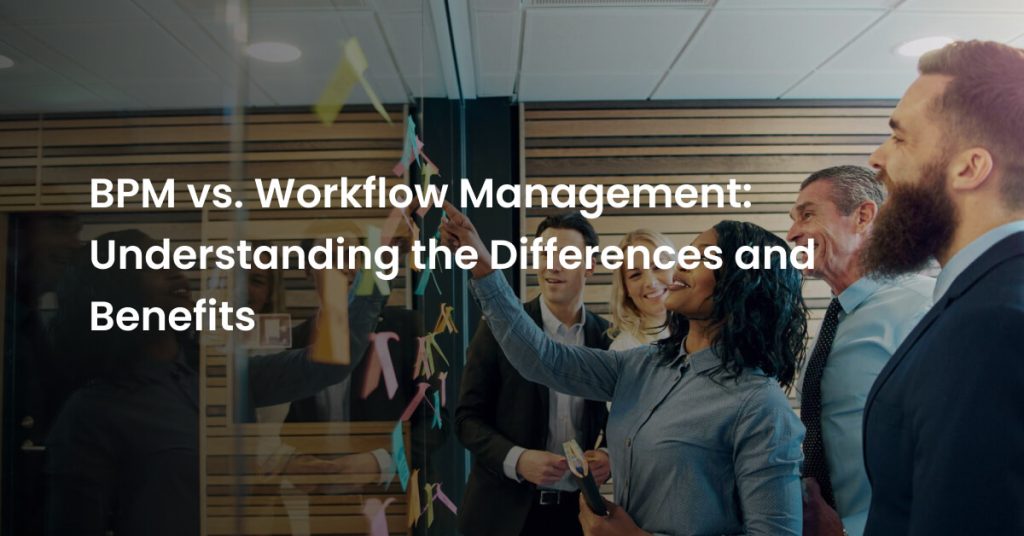
The business environment is grappling with too many technological similarities. We are here to clarify one such similarity between Business Process Management (BPM) and Workflow management. Are you wondering why suddenly such a clarification is needed? Well, it is high time to address the confusion so that organizations can benefit from either of them, which is likely a savior for businesses.
To understand the differences, it is important to know what each of the services has to offer for organizations struggling with complex business processes on a daily basis. Both BPM and workflow management are related to streamlining business processes that involve machine and human collaboration. Before having an overview, let’s analyze why BPM and workflow management seem highly related.
- Workflow management is a subset of BPM
- BPM and workflow management are organizational tools
- They both focus on automating business operations that occur in a particular order
- BPM and workflow management’s offering for businesses has always been to increase efficiency, productivity, and reduce costs.
The blog will be a read on the differences between business process management and workflow management, from which your business can derive detailed insights on the two and finally help you conclude which to choose for your business and management.
Understanding BPM: A holistic view
Just like every organization is in need of a manager who monitors, analyzes and tracks employee performance and gets the day’s tasks completed on time to achieve business productivity, a BPM solution works on a similar pattern. Observing the whole end-to-end process of business operations by implementing methods and tools that help discover, model, analyze and optimize strategies aligning both organizational goals and business objectives.
So how BPM works is exactly what we are going to discuss further in this blog. Providing holistic cross-functional management is quite tedious in this digital age, where businesses are connected with more devices than people. The following aspects are what business process management focuses primarily on having control over the entire business process to gain efficiency, agility and competitiveness.
Process identification: The BPM works by initially analyzing and documenting all the processes involved in an organization. It may range from simple operations to cross-functional processes to routine-based tasks.
Process modeling: The next step that follows in business process management is to create visual representations of the analysis. This helps in structuring the sequence of tasks, the responsibilities of people involved in the process, and the flow of the process.
Process analysis: Following the modeling process, it is time to monitor the flow for inefficiencies, bottlenecks, and areas for improvement. The analysis is done by reviewing the data collected from resource utilization, error-rates, and other information.
Process design and optimization: Once the analysis and monitoring process are done, the business process management solution assists organizations in redefining and redesigning the existing processes. From eliminating unnecessary workflows to simplifying processes to automating manual tasks, business process management proves to be an effective addition for businesses and organizations.
Automation and integration: Business process management leverages technologies like software tools that help automate processes, helping organizations have less reliance on manual interventions. Having access to business process automation platforms for modeling and visualizing processes helps businesses save time and effort in formulating solutions effectively and efficiently.
Monitor and control: Once the suggestions from BPM solutions are considered and implemented, it is time to perform a performance check on the integrated solution. Analyzing key performance indicators like throughput, customer satisfaction, and process flow helps regulate BPM services for further enhancement and improvement.
Continuous monitoring: Every digital transformation is a journey that requires several iterations and changes to keep pace with the demanding business environment. A continuous monitoring system is what helps foster innovation, continuous improvement and learning within the organization.
Thus, BPM solutions handle complex and cross-functional operations in an organization effectively, reducing the need for manual intervention for tasks of zero priority. To position your organization against an international standard, it is essential to streamline and regulate business processes.
Workflow management: A comprehesive guide
Now, the big question is, what is workflow management? Well, a related concept but on a smaller scale and methodology. Let’s analyze workflow management in detail.
Workflow management is similar to the role of a team leader (TL), who takes responsibility for a small team within the organization. So, workflow management is a set of pre-defined tasks within business process management. Thus clearly emphasizing that workflow management is a coordinating tool for task completion that will indirectly take care of process execution. The steps involved in workflow management are discussed below.
Task sequencing
Defining the sequence of tasks within the business process is essential to determining the order in which the tasks will be performed.
Task assignment
Once the task sequence is established, it is now assigned to the respective people or departments who will take care of the execution.
Task routing
In cases where tasks need to be routed to different departments based on predefined rules and criteria, workflow management makes use of automation tools that seamlessly streamline the routing process without manual intervention.
Task monitoring
Workflow management empowers organizations to track the status of tasks, enabling stakeholders to gain visibility into real-time inefficiencies and hindrances obstructing the workflow.
Task collaboration
Workflow management facilitates integrating feedback and reviews from stakeholders and approvals from teams, ensuring a collaborative approach to completing tasks efficiently and effectively.
Task integration
To have a seamless flow of data and feedback from one task to the next, workflow management makes sure the integration of tasks is robust and optimized.
Task automation
In routine based tasks, workflow management utilizes automation facilities that help regulate the tasks without human help, empowering employees to focus on business priorities.
Thus, workflow management operates by taking care of task sequence, flow and process by coordinating, collaborating, and integrating people and processes.
Exploring the advantages: A practical approach
Let’s consider a common stance where we can analyze the role of business process management and workflow management solutions that clearly depict the benefits of business process management and workflow management.
A B2B company that is into software development wants to optimize its process of timely delivery and high-quality performance. The role of business process management involves,
End-to-end process optimization
- As per BPM solution approach, it analyzes the entire process, right from client onboarding to post-deployment support.
- This helps in establishing rules and criteria for enhanced communication, collaboration and resource allocation.
- Also, business process management ensures alignment with organizational goals such as faster-time-to-market, customer satisfaction and increased throughput.
Cross-functional partnership
- Since it is an end-to-end management methodology, BPM solutions ensure departmental collaborations are well defined to promote a work culture where sales, design, development, and testing contribute to delivering a standard product.
- This facilitates knowledge sharing and knowing the responsibilities of every team that gets involved in the process.
Continuous improvement
- Once every requirement has been implemented, BPM solution monitors the process by tracking key performance indicators like client feedback score, project cycle time, defect density, iteration loops, and other metrics.
- Utilizing tools such as analytics and reporting ensures the company can adapt to evolving client needs and industry trends.
Now, let’s analyze how workflow management assists in this.
Coordination and automation
- Workflow management helps streamline and coordinate tasks. They sequence the flow of work, define responsibilities, and automate routine tasks that require less manual intervention
- For example, a workflow management solution can automate the process of code review by routing code changes to designated reviewers and tracking their progress through the review process.
Visibility and tracking
- Workflow management provides real-time visibility of the current status of tasks, assisting team members with feedback, deadlines, targets, and solutions.
- This approach helps stakeholders and other decision-makers know about project status, resource utilization, the next step phase, and other key parameters.
Understanding the differences
The key difference between business process management and workflow management is summarized below for a detailed understanding.
Features | BPM | Workflow |
|---|---|---|
Scope | Establishes end-to-end management | Manages task coordination within BPM |
Complexity | Deals with hard and cross-functional processes. | Assist organizations with simple and routine-based tasks. |
Flexibility | Adaptable to evolving organizational and business needs and demands | Based on pre-defined policies and rules. |
Technology | Utilizes a business process automation platform for process modeling, execution, and monitoring. | Handles routine-based tasks by automating through workflow engines and automation tools. |
Collaboration | Facilitates cross-departmental collaboration. | Enables collaboration among team members and integration with tools and systems. |
BPM or Workflow Management – The ultimate choice
The blog on BPM vs. workflow management emphasizes that digital transformation is the key to sustaining in the digital age. The need for automation and streamlining of business processes cannot be avoided, but what to choose between the two solely depends on your organization’s needs and business demands. But with the pace of digital transformation occurring, it is advisable to choose a BPM service that encompasses a holistic end-to-end management of business processes in one go.
To unlock the benefits of BPM and integrate the latest technologies, we would suggest you consider organizations like SquareOne Technologies, who have been in the business for a decade handling organizations of all sizes, to transform their business operations digitally. Selecting the right business process management model is as essential as having a business process management service provider, who ensures to take care of every requirement your business throws up as it expands. From assessing the right set of BPM tools to supporting post deployment facilities, SquareOne Technologies has excelled in its services. Elevate your business to the digital age with SquareOne Technologies!
Conclusion
While a business process management solution might seem like a mere addition to your organizational toolkit, it emerges as a crucial asset when navigating intricate business operations that demand collaboration across multiple departments. In such scenarios, a BPM solution proves invaluable. It not only streamlines processes but also meticulously identifies inefficiencies and eliminates redundant steps. Moreover, it doesn’t just stop there—it offers tailored solutions for areas that seek enhancement. As the business landscape evolves, embracing BPM ensures your organization stays ahead of the curve. Secure your position as a pioneer in optimizing your operations by integrating top-notch solutions through SquareOne Technologies today!

















